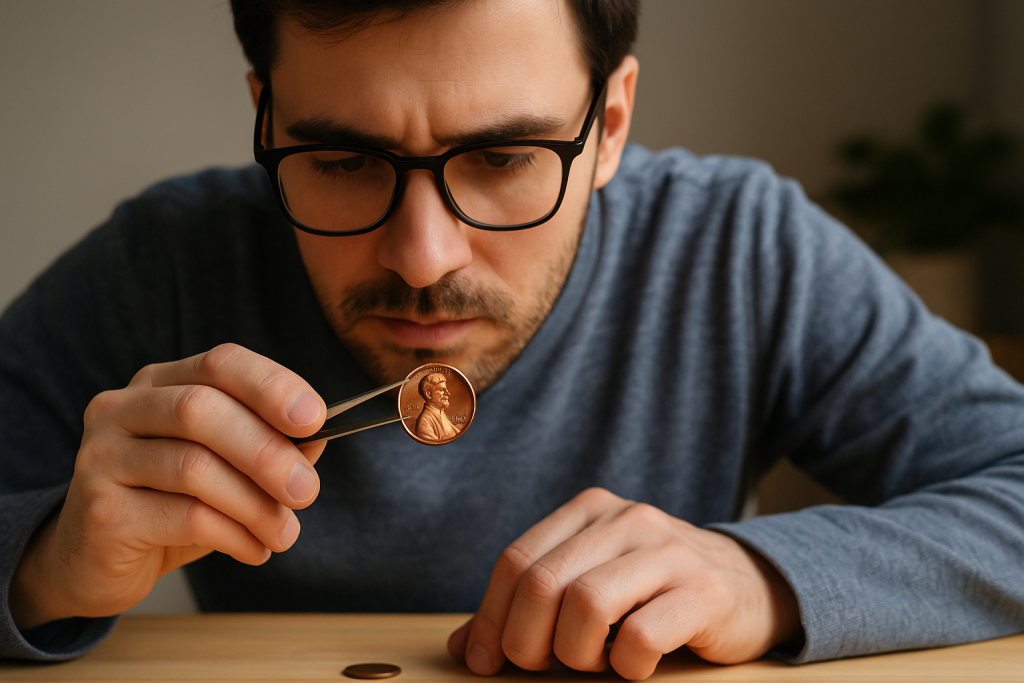The 1972 penny is one of the most discussed coins in the Lincoln Memorial Cent series. It became famous because of a rare striking variety known as the Doubled Die Obverse (DDO). This flaw appeared when the working hub hit the die twice in a slightly different position. The result – all letters and numbers on some coins show clear doubling.
A lot of doubling pieces entered circulation before the issue was found. Most of them are from the Philadelphia Mint, and collectors still search for them today. The same year also produced regular coins, minor die flaws, and machine doubling, which looks similar but has no extra value. So, stay with us to know the difference between an ordinary coin and a collectible one that is worth hundreds or more.
Coin Overview and Technical Specifications
The 1972 penny is part of the Lincoln Memorial Cent series. It replaced the earlier Wheaties in 1959 and was struck until 2008. Below are the basic details for the 1972 issue.
| Feature | Description |
| Year of issue | 1972 |
| Series | Lincoln Memorial Cent |
| Composition | 95% copper, 5% zinc |
| Weight | 3.11 g |
| Diameter | 19.05 mm |
| Edge | Plain |
| Mint marks | P (no mark), D (Denver), S (San Francisco) |
| Designer | Victor D. Brenner |
| Reverse design | Lincoln Memorial by Frank Gasparro |
| Variety types | Regular, Doubled Die Obverse, Proof, minor mechanical doubling |
The coin shows President Abraham Lincoln on the obverse. The reverse depicts the Lincoln Memorial with small visible details of his seated statue inside. The design stayed the same for decades, so the main differences between years come from small minting variations and die errors.

The Genuine 1972 Doubled Die
The true 1972 DDO came from a misaligned hubbing during die preparation. The working die received two impressions at slightly different angles. Every coin made from that die carries doubled details on the surface.
There are ten known DDO varieties for this year, labeled DDO #1 through #10. Only DDO #1 has clear, strong doubling visible without magnification. It is also the most valuable and popular among collectors.
Main identifiers of the genuine DDO #1:
- Strong doubling on IN GOD WE TRUST, especially the letters IN and TRUST.
- Visible doubling on LIBERTY and all four digits of the date 1972.
- The edges of doubled parts appear rounded and raised.
- No blurring or flattening between layers.
- Sharp, even spacing between the doubled elements.
These traits show that the doubling comes from the die, not from striking movement.
| Grade | Average Price | High Certified Example |
| Circulated | $100–$250 | — |
| Uncirculated (MS63–MS65) | $400–$800 | $1,000+ |
| MS66+ Red | $1,500–$3,000 | $3,500+ (record sales) |
Certified examples by PCGS and NGC often sell at premium auctions. Uncertified (raw) coins can also hold high value if the doubling is strong and surfaces are original. Even a lightly worn DDO #1 is worth checking.
What Is Machine Doubling
Machine doubling (MD) is not a minting variety. It happens during striking when the die bounces or shifts slightly after impact. This movement creates a flat, shelf-like outline around letters or numbers that is sometimes called “mechanical doubling” or “strike doubling”.
Unlike a Doubled Die, MD does not come from the die itself. It is a one-time event on each coin, caused by vibration or die wear. The result looks similar to true doubling but has no raised relief.
Main traits of machine doubling:
- Flat, thin extra edge around design elements.
- No separation line or depth between layers.
- The secondary outline looks lower than the main design.
- Affected areas may look smeared or slightly reduced in thickness.
- Usually seen on low-pressure strikes or worn dies.
MD appears often and has no added value. Most pieces with MD trade for face value, even in mint condition.
| Feature | Genuine DDO | Machine Doubling |
| Cause | Misaligned hub strikes | Die or planchet movement |
| Appearance | Raised, rounded doubling | Flat, shelf-like shadow |
| Value | High collector premium | Face value only |
| Frequency | Rare | Common |
How to Differ DDO from MD
Collectors often confuse the two. The best way to learn is to observe under different light and magnification. In general, you can simply follow recommendations:
- Height and relief: True DDO shows equal height and relief on both images, while machine Doubling is shallow and flat.
- Shape of the edge: DDO edges are smooth and rounded, while MD edges are thin, sharp, and appear stepped.
- Light reflection: DDO surfaces reflect light twice under angle, while MD produces a single flat shine.
- Distribution: DDO affects multiple letters evenly, while MD often affects random spots.
- Texture: In DDO, both layers share the same texture, in MD, the doubled part is smoother or slightly distorted.
Remember to use a 10x magnifier and bright natural light. Then move the coin slightly under light to see real depth differences. Most real doubled dies will show distinct separation lines.

Other 1972 Penny Varieties
Several other 1972 Lincoln cents were produced and are easier to identify than the major doubled die.
- The 1972-D from Denver is common and shows no significant doubling. Most coins from this mint were well-struck and have only minor surface wear.
- The 1972-S Proof issue was made exclusively for collector sets at the San Francisco Mint. It has a bright mirrored finish and sharp design details but no known doubled die varieties.
Minor mechanical doubling can appear on coins from all mints. It results from slight die movement during striking and holds no added value. A number of small striking faults are also found on 1972 cents, including die cracks, off-center strikes, and lamination flaws that give each coin a unique appearance.
| Error Type | Description | Value Range |
| Die crack on reverse | Thin raised line near “ONE CENT” | $5–$20 |
| Off-center strike | Part of the design missing from one side | $20–$80 |
| Lamination flaw | Surface peeling exposing the copper core | $10–$30 |
While none of these reach the market value of the 1972 DDO #1, they remain of interest to collectors who specialize in mint varieties and error coins. Each example reflects the small production variations that make this series so popular.
Common Collector Mistakes
Confusing MD for DDO
This is the most frequent mistake. Machine Doubling looks flat and thin, while a true Doubled Die shows raised, rounded letters and clear separation. Always check under bright light or magnification. Real doubling shows depth; machine doubling looks like a shallow step.
Cleaning the coin
Any cleaning lowers value. Polishing removes the natural mint luster and leaves fine scratches on the surface. Thus, collectors keep coins as found and avoid any chemical treatment.
Ignoring small details
Many beginners overlook tiny doubled letters or numbers. On the 1972 DDO, the difference can be seen on “IN GOD WE TRUST” or “LIBERTY”. Use a 10× magnifier and check the coin under light to notice these details before judging authenticity.
Trusting online photos blindly
Photos can be misleading. Lighting, shadows, and reflections often create the illusion of doubling. Always compare your coin directly in hand, not only by pictures.
Overvaluing weak MD coins
Coins with weak mechanical doubling are common and worth only face value. They are not true DDO pieces. Hub doubling shows full depth and spacing, while MD produces a thin, flat edge. Once compared side by side, the difference is easy to see and remember.
How to Verify and Document Your 1972 Penny
Organizing your finds helps long-term value. So, keep coins in acid-free holders and label each with mint, grade, and notes.
And remember that digital tools make this easier. The Coin ID Scanner app can identify coins by photo and detect mint marks and type. It stores high-quality images, compares values, and builds a catalog.
For example, you can check your 1972 penny details before sending it for certification. One photo in good light is enough to confirm the type and grade range.
What Every Collector Should Remember
The 1972 Doubled Die cent is a verified hub error with clear raised doubling on IN GOD WE TRUST, LIBERTY, and the date. Machine Doubling, often mistaken for it, is flat and holds no collector premium. Only the DDO #1 variety has real numismatic value.
Denver and San Francisco issues show no confirmed doubled dies. Proper inspection, comparison with certified examples, and accurate records through Coin ID Scanner ensure reliable identification and stable long-term value.


